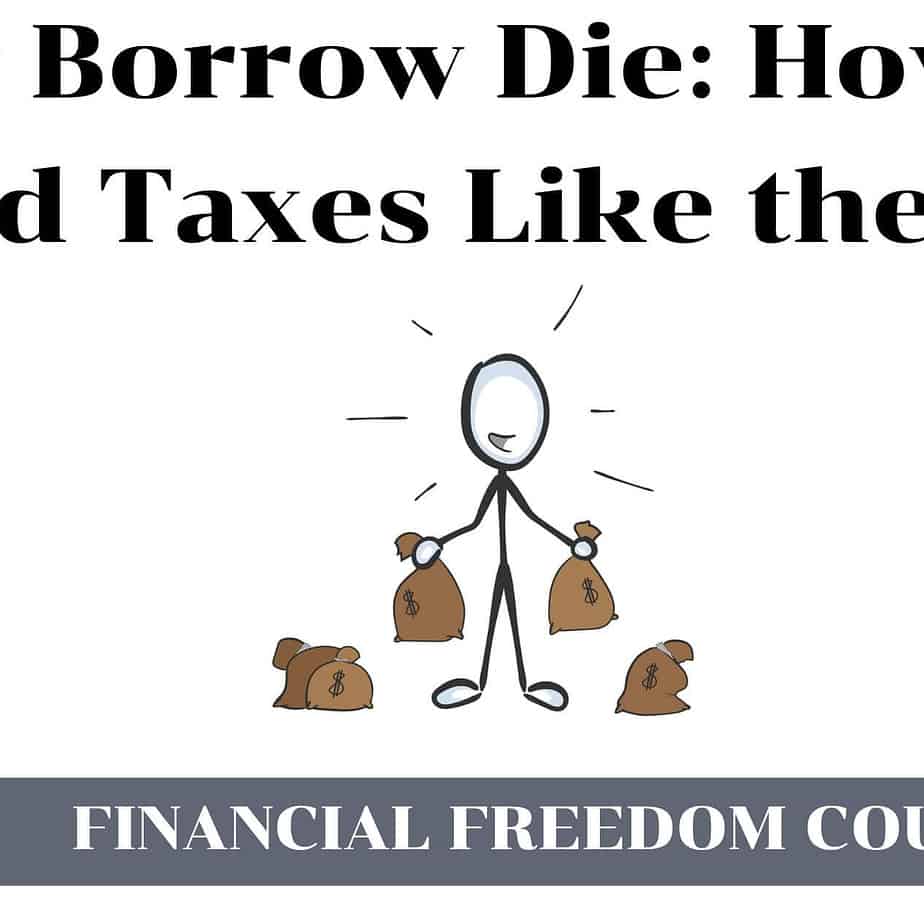Buy Borrow Die: How To Avoid Taxes Like the Rich

The “Buy, Borrow, Die” strategy has been adopted by affluent individuals who enlist the aid of financial planning specialists to maintain their lavish lifestyles while minimizing taxes.
Although the recent surge in asset prices combined with the low-interest rate environment made the strategy seem to be a recent phenomenon, Professor Ed McCaffery developed his iconic “Buy, borrow, die” theory in the mid-1990s to explain how the wealthy aren’t paying taxes because of perfectly legal reasons. Let us explore how we can adopt a similar strategy of borrowing money for living expenses instead of working for a living and what are the economic conditions to make it successful.
What Is Buy, Borrow, Die?
The ‘Buy, Borrow, Die’ concept explores how wealthy people can conserve their wealth for future generations by reducing their tax burden. The ‘buy, borrow, die’ strategy is aptly named due to its three basic steps: buy, borrow, and ultimately die, leaving your assets to your heirs and creating generational wealth.
The strategy depends on investing wisely and using legal tax planning loopholes instead of unscrupulous practices.
How Does a Buy, Borrow, Die Strategy Work?
Buy, borrow, die is a pretty straightforward strategy once you understand what each of the three steps stands for. Let’s look at each piece of the process to understand better what happens along the way.
Buy
First, a wealthy person must have a high amount of wealth and use that wealth to buy assets. These assets can be multifaceted and include both income-generating assets as well as appreciating assets like:
- Stocks
- Bonds or Fixed Income investments
- Real estate
- Artwork
- Alternative investments
Appreciating assets are preferred for this strategy due to the increase in value, so the usage of fixed-income investments would be low.
Investing in growth assets such as real estate or moonshot stocks lets you take advantage of their increased value over time.
Real estate investments are a favorite asset class for billionaires since it acts as an inflation hedge. Also, real estate permits leverage to be applied, which results in increased asset values.
Furthermore, investing in real estate has several tax advantages such as depreciation, 1031 exchange, QBI for rental property, mortgage interest deduction, etc. Additionally, if you have done a great job evaluating a rental property during purchase, you can benefit from passive real estate income in monthly rents.
Commercial real estate investments also provide passive income benefits through NNN leases.
Similarly, when investing in stocks, it is better to invest in growth stocks than value investing due to the rapid increase in asset values. Of course, dividend aristocrats provide a regular passive income stream but generally do not appreciate as much as moonshot stocks. Or one could try to get the best of both worlds by investing in the S&P 500 and similar broad-based index funds.
Art investments do increase substantially in value due to the scarcity factor. Often when an artist is famous and dies, the art pieces skyrocket since the former artist can create no more art.
Similarly, alternative investments depending on the scarcity and value of the asset, can increase in value. Investing in crypto has also proved highly profitable for the early adopters of bitcoin since only a limited number can exist based on the algorithm.
If you are not already setting aside money to buy assets, learn how to save money from your salary. Having a 7 figure salary or a similar high income makes it easier to have the extra money in your budget to set aside for investments. If not, learn how to develop high-income skills to increase your income.
Borrow
After acquiring assets that will appreciate, the next logical step is to take out loans secured by these assets. In other words, those resources can be utilized as collateral for borrowed money.
Instead of selling your investments for cash and triggering capital gains taxes, you could borrow money by pledging your assets as a surety.
Not only are you not liable for capital gains tax, but the loan proceeds will not be taxable income. In certain circumstances, when you use the money to acquire business assets, you can write off the interest portion of the loan based on your CPA’s guidance.
The most common method to do this is through a Securities Backed Line of Credit (SBLOC), where you can borrow money against the value of your stock portfolio. SBLOC has advantages such as flexible repayment terms, hassle-free approval (at no cost in some cases), and reduced interest rates.
Similarly, you can borrow for real estate or collectibles by pledging your property.
Die
For the “Die” portion of the “Buy, Borrow, Die,” your heirs receive a step-up in cost-basis of the assets when you die based on the current tax law.
With a buy, borrow, die plan in effect, those receiving your estate can use the assets you have bequeathed to settle any loans. This way, they won’t have to pay debts with their money.
Assume you bought the presently valued $1M worth of stock for $400,000 two years ago. So your cost basis is $400,000. If you sold it, you would pay long-term capital gains on the $600,000 profit.
When you die, the cost basis of the stock portfolio is reset to the present value of $1M. If your heirs sell the stock immediately, they have $1M in cash and pay zero taxes under current law.
Or they could use the buy, borrow, die strategy on the inherited assets and repeat the cycle.
Factors To Consider for the Buy Borrow Die Strategy
- The interest rate or your borrowing cost.
- How long do you need the money
- Capital Gains Tax rate
- Flat or rising asset values
One can invest wisely but can’t control the asset values.
Since the capital gains tax rate is usually static and requires an act of Congress to change, only the first two factors must be considered when deciding if the buy-borrow-die strategy works for you.
The same strategy works great in a low-interest rate environment because your total interest payments would be lower than your capital gain tax paid.
Also, it makes sense if you need the money for a short period or will die soon.
It would not work well to fund living expenses if you are an early retiree because you have a long lifespan ahead of you.
It will also not work if the asset values plunge drastically before the borrowing period ends.
Example of Buy Borrow Die Strategy
High-Interest Rate and Medium Time Frame
Say you borrow against $1M worth of assets at a 6% interest rate. So the interest amount you pay is $60,000/year or $300,000 over five years.
Conversely, let us calculate what happens if you sold the $1M in assets and realized long-term capital gain tax.
Assume you bought the presently valued $1M worth of stock for $400,000 two years ago. So your cost basis is $400,000. You would pay long-term capital gains on the $600,000 profit if you sold it.
Assume your capital gains tax rate is 20% so you would pay tax of $120,000 (20% of $600,000)
The tax free amount of $120,000 is much lower than the $300,000 interest payment and hence buy borrow die would not be a good strategy
High-Interest Rate and Short Time Frame
Let us take the same example of borrowing against $1M of assets at a 6% interest rate for only a year.
So the interest amount you pay is $60,000/year or $60,000 over one year.
Conversely, let us calculate what happens if you sold the $1M worth of assets at a long term capital gains tax rate of 20% with the same cost basis.
You would need to pay 20% taxes on $600,000 profit which works out to $120,000
In this case, you are better off using the buy borrow die strategy.
Low-Interest Rate and Short Time Frame
Assume we are borrowing against $1M of assets at a 1.5% interest rate but for only a year.
So the interest amount is only $15,000
Conversely, assume the same cost basis of $400,000 for the $1M assets giving us a long term gain of $600,000.
With a long term capital gains tax rate of 20%, we would be paying $120,000 on a $600,000 profit.
The buy-borrow-die strategy is superior to selling your assets and paying taxes.
Low-Interest Rate and Medium Time Frame
Assume we borrow against $1M of assets at a 1.5% interest rate for three years.
So the interest amount is only $45,000
Conversely, assume the same cost basis of $400,000 for the $1M assets giving us a long-term gain of $600,000.
With a long-term capital gains tax rate of 20%, we would be paying $120,000 on a $600,000 profit.
The buy-borrow-die strategy is vastly superior to selling your assets and paying taxes.
See below table for examples of borrowing against $1M worth of assets. Assuming capitals gains rate of 20% on $600,000 unrealized gains.
| Interest Rate | Period | Total Capital Gains Tax | Total Interest Rate | Verdict |
|---|---|---|---|---|
| 6% | 5 years | $120,000 | $300,000 | Sell |
| 6% | 1 year | $120,000 | $60,000 | Buy, Borrow, Die |
| 1.5% | 1 year | $120,000 | $15,000 | Buy, Borrow, Die |
| 1.5% | 3 years | $120,000 | $45,000 | Buy, Borrow, Die |
Risk of Buy Borrow Die Strategy
The most significant risk of the strategy is that it works well only in a flat or rising stock market. If the asset value declines sharply, the lender could trigger a margin call and ask you to post additional collateral or sell the pledged assets.
Due to these risks, using the buy-borrow-die strategy on your primary residence is never recommended to avoid foreclosure risk. A 15 or 30-year mortgage should always secure your primary home.
Although HELOC and cash-out refinancing is popular, always proceed cautiously.
Who Would Use Buy Borrow Die
The strategy is regularly used by wealth management clients looking to minimize capital gain and income tax. No one likes to pay taxes, and individuals with a high annual income and many assets may be able to use this strategy to minimize their overall tax burden.
The current tax law enables such a plan, making the Buy Borrow Die strategy viable for individuals with access to the resources to pull off such a plan. However, taking advantage of Buy Borrow Die presupposes a few things.
First and foremost, an individual must have the assets to be used as collateral against any loan that is taken out. Using the Buy Borrow Die strategy means you can afford to buy and pay off these assets from a non-taxable or taxable account.
Next, an ultra-wealthy person using the Buy Borrow Die strategy must use an asset that avoids tax. For example, if you have assets in a tax-deferred account such as a 401(k), you would be unable to access attractive, low interest rates used for borrowing money. Additionally, there are restrictions on the repayment schedule of tax-deferred accounts.
Individuals using the Buy Borrow Die strategy must understand the broader implications of how such a plan may impact their overall wealth picture.
For example, how will borrowing against your assets impact your long-term financial plans?
Will it impact your average net worth?
How will it benefit your cash flow or make it harder to repay the money?
How will you use the loan proceeds? Do you plan on using them for new business ventures or to manage the regular costs of life?
Are there ways you can use the borrowed money as leverage to gain access to additional financial opportunities?
As you can see, these are all deeply complicated and intricate questions, leading to a secondary issue: Do you have the right financial and investment advice?
This advice must exist on multiple fronts.
You’ll need to consult with an investment advisor who can advise you on the best stock or appreciating asset to use. Also, a tax advisor can plan the appropriate estate tax mitigation strategy. And finally, an estate planner and lawyer to provide legal advice.
Why Buy Borrow Die Strategy Might Not Work
First, most people will need access to the necessary financial mechanisms, advice, or assets that will allow them to avoid tax in this manner.
Secondly, an individual cannot afford to become over-leveraged. Individuals may have assets they could borrow against, including a home equity or securities-backed line. However, this strategy may have other impacts on someone’s primary residence and overall liquid net worth.
Finally, this plan for the ultra-wealthy only really works in a low-interest rate, high capital gains tax environment. As such, the loan’s structure or any collateral-backed loan is critical. How much interest will a person ultimately repay over the course of a loan? What is the interest rate? Is it worth it in the long run?
These and other strategies are complicated questions that most individuals – even the ultra-wealthy – don’t have the expertise to answer on their own. It is usually beneficial for someone to have outside financial advice that lets them answer these questions and determine if such a loan strategy is indeed worth it.
What Are the Societal Implications of Buy Borrow Die
From a societal perspective, the challenges are clear. Buy Borrow Die allows a person to avoid paying taxes on their income and still gain access to the same money they would have if they sold their assets. In this regard, Buy Buy Borrow Die enhances tax inequality, allowing people to avoid taxes on their wealth.
Many have argued that Buy Borrow Die is another example of a taxation system stacked in favor of the wealthy, and it is a plan that continues to gain attention. After all, people who are cash poor and don’t have investment resources can’t get a line of credit to buy groceries. These people can’t avoid sales or income tax on specific items and living expenses, but the wealthy can. Buy Borrow Die isn’t an option for someone without a massive amount of financial resources.
Furthermore, because Buy Borrow Die minimizes the tax burden, it leaves more money for individuals to pass down to their families. This allows someone to build generational wealth to pass down to their family members.
Over time, this wealth will likely continue to build. In theory, tax revenue that could be generated from the estate taxes that are avoided via Buy Borrow Die could be invested into more opportunities for individuals who are part of the working or middle class, giving them greater access to the benefits that people who are wealthier have.
Indeed, McCaffery believes the crux of much of the argument against Buy Borrow Die is that it helps the rich get richer and forces the poor to stay poor.
Is the Buy Borrow Die Strategy Right for Me
There is no question that Buy Borrow Die takes advantage of existing loopholes and current laws within the American tax system. To be clear, it is popular because this strategy works and is perfectly legal.
Anyone can implement the Die part of the Buy Borrow Die strategy. A stepped-up cost basis is available as part of the same income tax code, and the exemption for inheritance tax is sufficiently large.
Even if you do not implement the buy borrow die strategy, ensure you have a revocable living trust created to avoid the government taking a substantial chunk of your money via probate.
Chadwick Boseman died without a will, and his estate was subject to probate as per California law. His estate lost nearly a quarter of its value in settlement fees due to lacking a living trust.
Trust & Will provides state-specific trusts to protect and transfer your most important financial assets. You can also nominate legal guardians for your children to ensure they are looked after by someone you know and trust in case something happens to you.
The biggest impediment to the strategy is having enough assets to pull it off. You must be fiscally responsible and develop multiple types of income to accumulate assets.
Is it right for you? Ultimately, you, your family, and your financial advisors can only answer that question. Use the sample examples in the article above to have a rough idea if the numbers work in your favor.
As always, tax professionals can help you determine if and how you can use this system to generate wealth tax-free.

John Dealbreuin came from a third world country to the US with only $1,000 not knowing anyone; guided by an immigrant dream. In 12 years, he achieved his retirement number.
He started Financial Freedom Countdown to help everyone think differently about their financial challenges and live their best lives. John resides in the San Francisco Bay Area enjoying nature trails and weight training.
Here are his recommended tools
M1 Finance: John compared M1 Finance against Vanguard, Schwab, Fidelity, Wealthfront and Betterment to find the perfect investment platform. He uses it due to zero fees, very low minimums, automated investment with automatic rebalancing. The pre-built asset allocations and fractional shares helps one get started right away.
Personal Capital: This is a free tool John uses to track his net worth on a regular basis and as a retirement planner. It also alerts him wrt hidden fees and has a budget tracker included.
Streitwise is available for accredited and non-accredited investors. They have one of the lowest fees and high “skin in the game,” with over $5M of capital invested by founders in the deals. It is also open to foreign/non-USA investor. Minimum investment is $5,000.
Platforms like Yieldstreet provide investment options in art, legal, structured notes, venture capital, etc. They also have fixed-income portfolios spread across multiple asset classes with a single investment with low minimums of $10,000.






